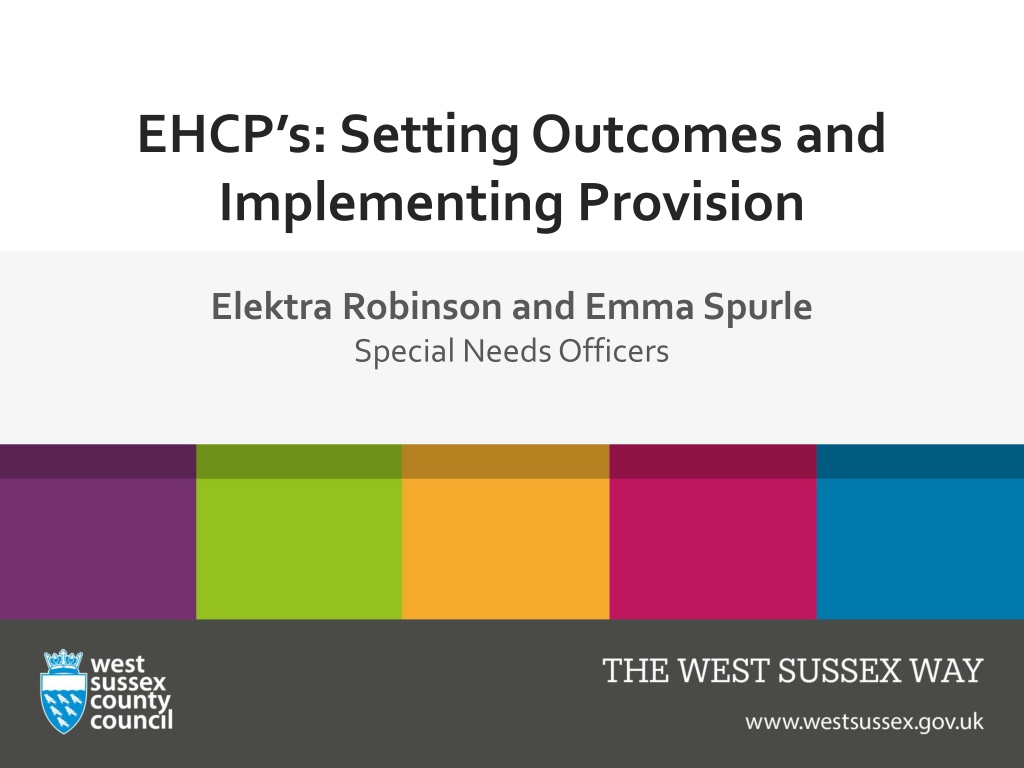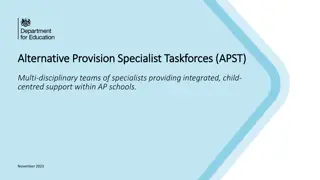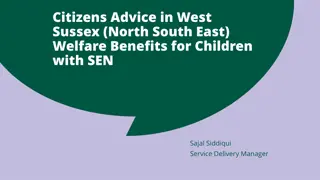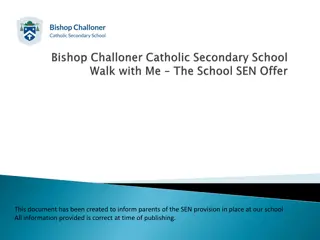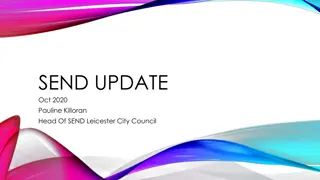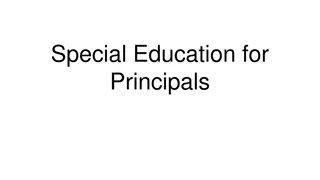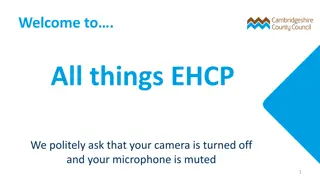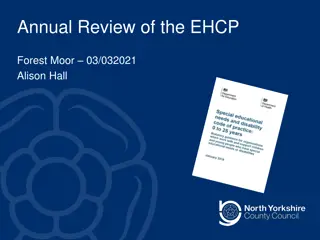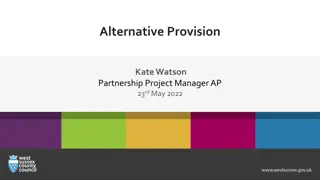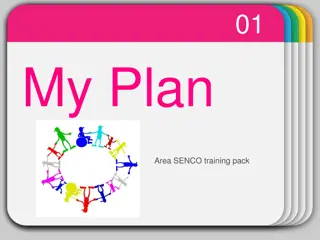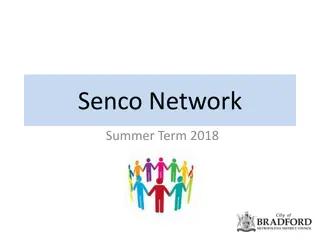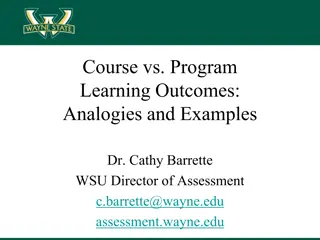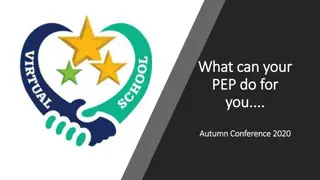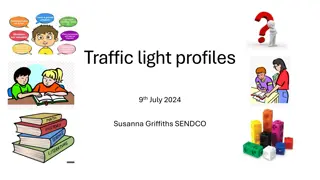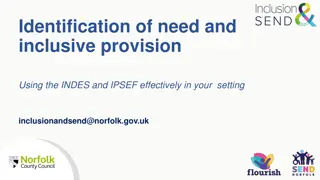Understanding EHCP Outcomes and Provision for Special Educational Needs
EHCP outcomes and provision for special educational needs are crucial components outlined in a child or young person's Education, Health, and Care Plan (EHCP). Long-term outcomes are categorized into learning areas, while medium-term outcomes serve as steps towards achieving long-term goals. It is important to set SMARTER outcomes, ensuring they are Specific, Measurable, Achievable, Relevant, Time-bound, Evaluated, and Reviewed. These outcomes are reviewed annually with parents, professionals, and the young person to track progress and adjust as needed.
Download Presentation

Please find below an Image/Link to download the presentation.
The content on the website is provided AS IS for your information and personal use only. It may not be sold, licensed, or shared on other websites without obtaining consent from the author. Download presentation by click this link. If you encounter any issues during the download, it is possible that the publisher has removed the file from their server.
E N D
Presentation Transcript
EHCPs: Setting Outcomes and Implementing Provision Elektra Robinson and Emma Spurle Special Needs Officers
EHCP Outcomes and Provision Special Educational Needs Outcomes and Provision are detailed in Sections E and F of a child or Young Person s Education, Health and Care Plan (EHCP)
Setting Outcomes Long Term Outcomes are identified in section E and are split into the four areas of learning: Cognition and Learning Communication and Language Sensory and/or Physical Social, Emotional and Mental Health
Long Term Outcomes The Long Term Outcomes are usually set to be achieved by the end of a Key Stage, depending on the age of the child/Young Person when the EHCP was finalised: End of Foundation Stage End of Key Stage 1 End of Key Stage 2 End of Key Stage 3 etc The Long Term Outcomes represent reasonable and aspirational targets for the child/young Person. Outside agencies working with the child/ young person may have contributed to these long term outcomes. All outcomes will be reviewed with parents, professionals and the young person at the annual review, arranged by the educational setting.
Examples of Long Term Outcomes Cognition and Learning Use an extended range of toys in a functional way Demonstrate increased literacy and numeracy skills Communication and Language Be able to communicate with a range of people using PECS Will demonstrate increased attention and listening skills Sensory and/or Physical Be able to understand the undressing /dressing procedures and offer as much help as possible when changing for P. E and putting on his/her coat for outdoor play Will demonstrate increased gross and fine motor skills. Social, Emotional and Mental Health Will have positive relationships with key members of school staff
Medium Term Outcomes Medium term outcomes should be set at the Annual Review. These will then be worked on over the next 12 months. They should be the steps that need to be worked on to achieve the long term outcomes stated in the EHCP.
SMARTER OUTCOMES When setting outcomes, remember to ensure they are SMARTER: Specific Measurable Achievable Relevant Time bound Evaluated Reviewed
Short Term Outcomes Medium term targets should be broken down into small steps, which will be the pupil s short term targets. These are the targets that should be recorded on the pupil s Individual Leaning Plan (ILP). These targets will be reviewed termly by the educational setting, parents and other relevant professionals.
Examples of SMARTER Short Term Outcomes To learn all set 1 sounds by the end of the summer term To stay on task for 5 minutes 80% of the time by October half term To use his knife to independently cut large pieces of food four days out of five by the end of May half term Be confident using a help card to request adult input the end of the Spring term With prompting, request an item in exchange for a symbol using PECS by the end of the Autumn term
Reviewing and Evaluating Outcomes EHCPs must be formally reviewed annually at the Annual Review for children aged 5+ Under 5 s should have their EHCPs reviewed every 6 months Targets on Individual Learning Plans should be reviewed termly and new steps identified in the light of the progress made by the child/young person
A Continuous Cycle Setting and reviewing outcomes is a continuous cycle. Information regarding the progress made by the child/young person across the three terms is reviewed as part of the annual review process. At each ILP review, new short targets will be set for the following term. At each Annual Review new medium term outcomes will be set for the forthcoming year.
Provision Will be stated on the EHCP in section F Is personalised to the child or young person Should be reviewed throughout the year and formally at their annual review Should be adapted to meet the evolving needs of the pupil Should be informed by all those involved with the child or young person s education Implementing Provision Provision will be implemented through interventions and by providing specialist resources and equipment or by accessing specialist support The relevance of the provision should be reviewed alongside the outcomes and adapted and changed when appropriate.
Amendments to EHCP Outcomes and Provision Amendments to the outcomes and provision on an EHCP should be requested if the existing ones are no longer appropriate, or if further information has been received regarding the child or young person s special educational needs and/or the provision they require. Requests for amendments can be made by parents or guardians directly to SENAT, or requested as part of the annual review process. It should be clearly recorded on the annual review form when amendments are being requested and supporting evidence should be submitted along with the annual review paperwork. If SENAT agrees to amend the EHCP, a draft amended EHCP would be issued and there would be a 15 day response time before the final EHCP was issued. If SENAT does not agree to amend the EHCP, the child s parents or guardians will be informed along with information on how to appeal this decision if they wish to do so.
SENAT Contact details: North Team Inbox: SENAT.north@westsussex.gov.uk Special Needs Officers (SNOs) North Team: Sharon Smith - Sharon.smith@westsussex.gov.uk Kim Heden - kim.heden@westsussex.gov.uk Elektra Robinson Elektra.Robinson@westsussex.gov.uk South Team Inbox: SENAT.south@westsussex.gov.uk Special Needs Officers (SNOs) South Team: Emma Spurle Emma.spurle@westsussex.gov.uk Sam Mainwaring - sam.Mainwaring@westsussex.gov.uk Claire Fowler Claire.fowler@westsussex.gov.uk School s first point of contact will be the Planning Co-Ordinator (PC) allocated to your school. Please email the Team Inbox or your area SNO if you are unsure who your named Planning Co-Ordinator is.
Thank you We hope you have found this information useful.
